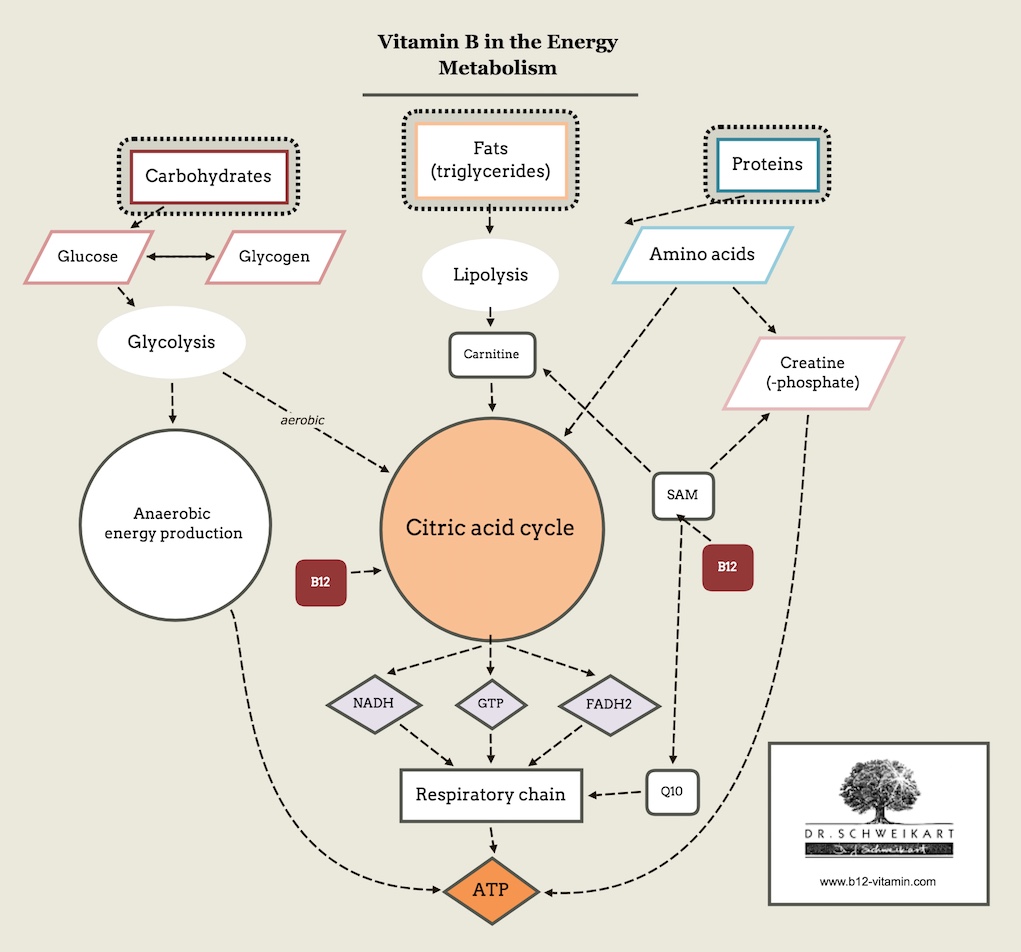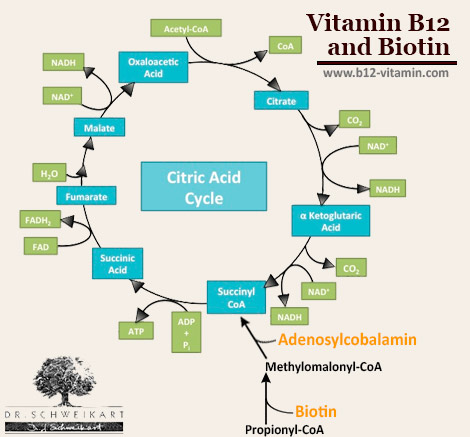Vitamin B12 – The Energy Vitamin?
Vitamin B12 is often sold as the vitamin for improving performance and energy – and for good reason. Amongst the many beneficial workings of vitamin B12 are several that have a major influence on the body’s energy production and help combat various forms of exhaustion and fatigue.
Nonetheless, it is important that such assertions do not lead to a misunderstanding. Firstly, exhaustion and tiredness are very unspecific symptoms, which can occur as a result of many different nutrient deficiencies, toxins or infections. Consequently, there are often multiple causes behind these symptoms as well as, or in addition to, a lack of vitamin B12.
Secondly, vitamin B12 is not a drug like caffeine but a nutrient. It does not lead to a short-lived energy boost, but instead stabilises and increases the energy level in the long term. The vitamin’s effects therefore only occur and have a significant impact after a steady, regular intake. The correct dosage, right cofactors and a consistent intake are all crucial factors in obtaining optimal results.
This article will explore when and how vitamin B12 can help in the case of chronic fatigue, low energy and exhaustion.
How does Vitamin B12 Combat Fatigue and Exhaustion?
Vitamin B12 influences the body’s general level of energy in multiple ways and in different forms. There are three natural forms of vitamin B12 that occur in the body and foods, which each fulfil a distinct biological task.
Methylcobalamin
Works in the cell plasma as part of the methylation cycle, in which the universal methyl donor S-adenosylmethionin (SAM) is produced. SAM is indispensable for a whole range of central bodily processes in energy generation. In addition to this, methylcobalamin regenerates folic acid, so the latter can complete its role in cell division and blood production.
Adenosylcobalamin
Takes effect in the mitochondria – the energy “power plants” of our cells – as part of the citric acid cycle. The latter is the most vital metabolic cycle for the generation of energy.
Hydroxocobalamin
Is an excellent radical scavenger and detoxifier, although it is not an active coenzyme form of B12. It protects against energy loss through pollution.
Together, these three B12 forms influence energy levels in the following ways:
- Blood production (methylcobalamin)
B12 deficiency leads to anaemia. As the body’s oxygen supply and therefore energy production sinks dramatically, chronic weakness sets in. - Production of creatine, carnitine and the coenzyme Q10 (methylcobalamin)
As mentioned above, vitamin B12 is required for the synthesis of the universal methyl donor SAM, which is needed for the synthesis of creatine, carnitine and the coenzyme Q10. Each of these three substances play a central role in energy generation. - Energy production in the mitochondria (adenosylcobalamin)
B12 is an important cofactor in the citric acid cycle: the central cycle in the production of energy in the mitochondria. When B12 is deficient, the conversion of fat and ketones into energy is reduced, plus harmful MMA acid is generated, which severely impairs energy production from glucose and glutamic acid. - Detoxification
Vitamin B12 itself is a major antioxidant and detoxifying agent of many chemical substances. Oxidative stress inhibits cell functions and energy production. A deficiency of B12 can also lead to a glutathione deficiency, which is the most essential antioxidant in the human body. The resulting oxidative stress significantly decreases energy levels.
Supplementing Vitamin B12 to Increase Energy
Since all three natural forms of the vitamin have an independent effect on energy production, the best B12 supplements contain a combination of each.
Form | Dose | Intake |
Combination of methylcobalamin, hydroxocoblamin and adenosylcobalamin | 1000 µg | Daily |
In the following, we will take a detailed look at the ways in which vitamin B12 influences energy levels.
Vitamin B12, Energy and Blood
Together with folic acid, in the form of methylcobalamin, vitamin B12 plays an essential role in cell division and the synthesis of new DNA. The vitamin is thus vital for the regeneration of the body’s tissues and organs, as well as for the new formation of blood (1).
If there is a shortage of B12, the creation of red blood cells – responsible for the transportation of oxygen around the body – is disturbed. Oxygen is however urgently required in the cells, in order to produce energy.
In the case of vitamin B12 deficiency, there is not enough red blood cells in the blood, which means that less oxygen can travel from the lungs to the cells. Therefore, the body has less energy available.
The consequent anaemia can cause a severe state of exhaustion and lead to a drastic drop in physical and mental performance. If B12 is appropriately supplemented, people with a severe deficiency will experience dramatic improvements, as will those with latent deficiency.
Creatine, Carnitine and Coenzyme Q10
Methylcobalamin is required for the synthesis of the central methyl group donor S-adenosylmethionine (SAM). SAM has an essential role in countless processes. For instance, it is directly required for the synthesis of creatine, carnitine and the coenzyme Q10, which are all pivotal to the generation of energy (2, 3).
Creatine is a central substance in supplying the muscles, nerves and brain with energy. It is required for the reconversion of the universal energy carrier, adenosine triphosphate (ATP). ATP stores energy from food and makes it available everywhere in the body, wherein it converts back into adenosine diphosphate (ADP). Creatine is involved in “recharging” this ADP with energy, through which it reconverts into ATP and is available to the body once again (4). A deficiency of creatine therefore rapidly leads to exhaustion and poor physical/mental performance.
Carnitine likewise place an essential role in the energy metabolism. It is responsible for channelling fatty acids into the mitochondria; only when bound to carnitine, can fatty acids get into the mitochondria, where they are converted into energy. If there is a carnitine deficiency, the body cannot access and use a vital energy source. Performance decline, muscle loss and a dangerous accumulation of lipids follow (5).
Coenzyme Q10 (also known as: ubiquinone) has a vital job in the respiratory chain and in so-called “oxidative phosphorylation”. This coenzyme is the most important way through which the body converts energy from foods into ATP – over 90% of the total energy in the body (ATP) is generated in this way. Deficiency of coenzyme Q10 results in general weakness, intolerance to all forms of exertion, extreme muscle weakness and can lead to severe multisystemic diseases, such as mitochondrial encephalomyopathy (6).
Vitamin B12 and Energy Production in the Citric Acid Cycle
Vitamin B12 as adenosylcobalamin takes effect in the mitochondria as part of the citric acid cycle (also known as the Krebs, citrate or tricarboxylic acid cycle – TAC). The citric acid cycle is regarded as one of the most important metabolic reaction pathways in our cells; a major junction point in many different metabolic processes.
The citric acid cycle is not only the aim of aerobic energy production, but also the starting point for many further metabolic cycles, since it provides various starting materials that are needed by the body for the formation of tissues and metabolic products (7).
This cycle is thus an amphibolic process: it involves both catabolism – the breakdown of metabolic products for detoxification and energy production; and anabolism – the formation of molecules and tissues. The exact mechanisms are as follows:
- Catabolism: the generation of energy
The citric acid cycle converts the metabolic degradation products into the energy-rich enzymes NADH and FADH2, which are transformed into ATP in the respiratory chain. - Anabolism: biosynthesis of central cellular precursors
The citric acid cycle produces the preliminary substances needed for a whole range of processes, such as the synthesis of proteins, amino and fatty acids – needed for the formation of tissues and cell membranes.
In addition, more recently other functions of the citric acid cycle have become known, such as its detoxifying effect and role in combating free radicals (8).
Energy Production in the Citric Acid Cycle
In the citric acid cycle, the digestive products taken from carbohydrates, fats and proteins are converted into usable energy. This resulting energy is stored in energy-rich enzymes and can then be used in further reactions.
The citric acid cycle therefore does not directly produce ATP, but stores energy in the form of guanosine triphosphate (GTP) and the energy-rich coenzymes NADH and FADH2. From these, the universal energy carrier ATP is obtained in the respiratory chain.
Adenosylcobalamin in the Citric Acid Cycle
Vitamin B12 in the form of adenosylcobalamin is responsible for the transportation of a central metabolic product of the citric acid cycle: succinyl-CoA.
The exact reaction in which B12 is involved here, is the conversion of methylmalonyl-CoA into succinyl-CoA, which requires adenosylcobalamin as a cofactor.
If there is a deficiency of adenosylcobalamin, methylmalonyl-CoA cannot be further processes and accumulates. Part of this is then converted into toxic methylmalonic acid (MMA) – this is why one of the means of testing for vitamin B12 deficiency is by measuring the MMA level in a urine test. MMA has neurotoxic properties and moreover leads to the death of neurons, changes more than 500 epigenetic markers and restricts glycolysis. A lack of adenosylcobalamin thus has a doubly negative impact on energy production (9).
Methylmalonyl-CoA, on the other hand, can only be formed with a sufficient supply of biotin. If biotin is missing, the metabolic chain is likewise impeded.
Vitamin B12, Oxidative Stress and Detoxification
Vitamin B12 is not only an important coenzyme, but also a potent detoxifier and radical scavenger. Oxidative and nitrosative stress, as well as exposure to toxins, lead to higher energy consumption and have a negative effect on energy production.
B12 in the form of hydroxocobalamin is one of the most important scavengers of nitrogen oxide (NO) radicals. The nitrosative stress caused by NO is suspected to be a central cause of chronic fatigue and numerous other conditions (10). Hydroxocobalamin also removes various toxins such as cyanide and is used in this capacity as an emergency remedy for severe smoke poisoning (11). B12 also protects against oxidative damage caused by various genotoxic substances (12).
New research has also shown that the vitamin may have a previously underestimated effect as a cellular signalling substance, directly regulating the production of the body’s own radicals (13, 14). The vitamin would thus play a central role in the control of free radicals.
Also quite recent was the discovery that the reduced cobalamins produced in the body (without the side group) and some of the barely-researched exotic B12 forms, act as extremely strong antioxidants, the effectiveness of which is in no way inferior to glutathione or superoxide dismutase (15, 16).
Methylcobalamin deficiency also has a negative effect on the production of the important antioxidant glutathione, as it leads to the misregulation of the methylation cycle (17).
Taken together in its different forms, B12 is an essential vitamin for counteracting oxidative stress, toxins and inflammation, all of which have strongly negative effects on energy.
Conclusion: Vitamin B12 and Energy
Vitamin B12 has a rightful reputation as the energy vitamin. By supporting numerous processes crucial for energy production, it can positively influence energy levels and improve the body’s performance. All three natural B12 forms have their own specific effects; a supplement which contains a combination is therefore optimal.
Sources
- Rojas Hernandez CM, Oo TH (2015) Advances in mechanisms, diagnosis, and treatment of pernicious anemia. Discov Med 19:159–168 PMID: 25828519
- Brosnan JT, Jacobs RL, Stead LM, Brosnan ME (2004) Methylation demand: a key determinant of homocysteine metabolism. Acta Biochim Pol 51:405–413 PMID: 15218538
- Tran UC, Clarke CF (2007) Endogenous synthesis of coenzyme Q in eukaryotes. Mitochondrion 7, Supplement:S62–S71 DOI: 10.1016/j.mito.2007.03.007
- Wyss M, Smeitink J, Wevers RA, Wallimann T (1992) Mitochondrial creatine kinase: a key enzyme of aerobic energy metabolism. Biochim Biophys Acta 1102:119–166 PMID: 1390823
- Rebouche CJ, Engel AG (1983) Carnitine metabolism and deficiency syndromes. Mayo Clin Proc 58:533–540 PMID: 6348429
- Quinzii CM, DiMauro S, Hirano M (2007) Human Coenzyme Q10 Deficiency. Neurochem Res 32:723–727 PMCID: PMC1832150
- Berg JM, Tymoczko JL, Stryer L (2002) The Citric Acid Cycle. Biochemistry (Mosc.)
- Mailloux RJ, Bériault R, Lemire J, Singh R, Chénier DR, Hamel RD, Appanna VD (2007) The Tricarboxylic Acid Cycle, an Ancient Metabolic Network with a Novel Twist. PLoS ONE. doi: 10.1371/journal.pone.0000690 PMCID: PMC1930152
- Han L, Wu S, Han F, Gu X (2015) Insights into the molecular mechanisms of methylmalonic acidemia using microarray technology. Int J Clin Exp Med 8:8866–8879 PMCID: PMC4538064
- Pall ML (2000) Elevated, sustained peroxynitrite levels as the cause of chronic fatigue syndrome. Med Hypotheses 54:115–125 PMID: 10790736
- Hall AH, Borron SW (2015) Cyanide antidotes in current clinical use: hydroxocobalamin. Toxicol Cyanides Cyanogens 304–308
- Alzoubi K, Khabour O, Hussain N, Al-azzam S, Mhaidat N (2012) Evaluation of vitamin B12 effects on DNA damage induced by pioglitazone. Mutat Res Toxicol Environ Mutagen 748:48–51 DOI: 10.1016/j.mrgentox.2012.06.009
- Wheatley C (2007) Cobalamin in inflammation III — glutathionylcobalamin and methylcobalamin/adenosylcobalamin coenzymes: the sword in the stone? How cobalamin may directly regulate the nitric oxide synthases. J Nutr Environ Med Bsnm Br Soc Nutr Med Aaem Am Acad Environ Med Bsaem Br Soc Allergy Environ Med Acnem Aust 16:212–226 PMCID: PMC2556188
- Wheatley C (2007) The return of the Scarlet Pimpernel: cobalamin in inflammation II — cobalamins can both selectively promote all three nitric oxide synthases (NOS), particularly iNOS and eNOS, and, as needed, selectively inhibit iNOS and nNOS. J Nutr Environ Med 16:181–211 PMCID: PMC2556189
- Birch CS, Brasch NE, McCaddon A, Williams JHH (2009) A novel role for vitamin B12: Cobalamins are intracellular antioxidants in vitro. Free Radic Biol Med 47:184–188 DOI: 10.1016/j.freeradbiomed.2009.04.023
- Suarez-Moreira E, Yun J, Birch CS, Williams JHH, McCaddon A, Brasch NE (2009) Vitamin B 12 and Redox Homeostasis: Cob(II)alamin Reacts with Superoxide at Rates Approaching Superoxide Dismutase (SOD). J Am Chem Soc 131:15078–15079 DOI: 10.1021/ja904670x
- Nathan N, Van Konynenburg RA (2009) Treatment Study of Methylation Cycle Support in Patients with Chronic Fatigue Syndrome and Fibromyalgia.



